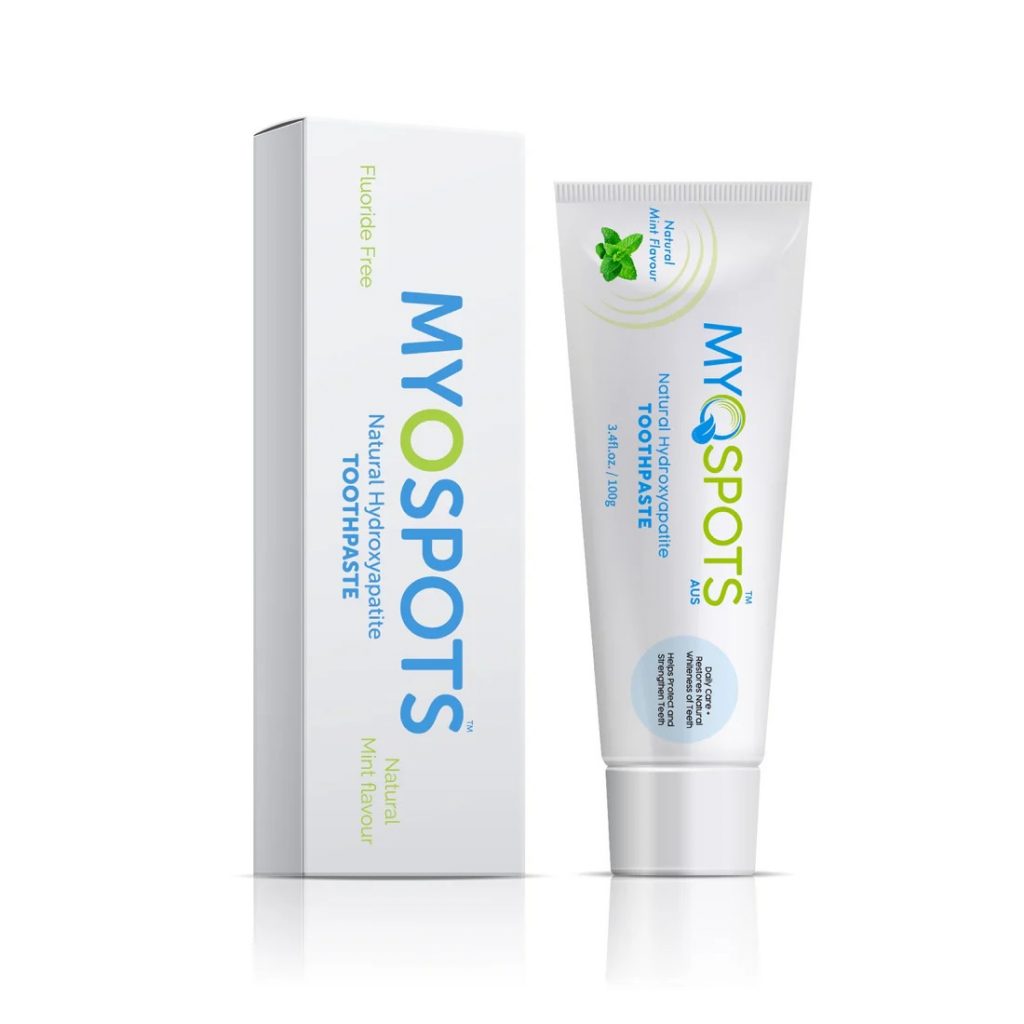
Myospots: Fix Poor Tongue Posture vs. Tongue Tie Explained
Do you snore? Do you wake up with a dry mouth or jaw pain? Have you always struggled with a “gummy” smile or feel like your teeth are shifting even after braces?
If you’ve ventured down the health-info rabbit hole, you’ve almost certainly encountered the term “tongue tie.” It’s become a major buzzword, and for good reason. But here’s the secret: for a vast majority of adults struggling with these symptoms, the problem isn’t a physical tongue tie.
It’s something far more common and, luckily, far easier to fix.
Welcome to the critical, often-overlooked difference between a structural problem (tongue tie) and a habitual one (poor tongue posture). Understanding this difference is the key to unlocking better sleep, improved breathing, and lasting health benefits.
And this is where Myospots comes in. This simple, innovative tool is the breakthrough you’ve been looking for to correct the habit, all without expensive therapy or invasive procedures.
What is Tongue Tie (Ankyloglossia), Really?
Before we can understand what we don’t have, let’s clarify what a true tongue tie is.
A tongue tie, known medically as ankyloglossia, is a physical, structural condition. It’s congenital, meaning you are born with it. It occurs when the small band of tissue connecting the underside of the tongue to the floor of the mouth (the lingual frenulum) is abnormally short, thick, or tight.
Think of it as a small tether holding your tongue down. Because it’s a physical tether, it physically restricts the tongue’s range of motion.
In infancy, this is often diagnosed early because it can severely impact breastfeeding. The baby can’t properly latch or create suction because the tongue simply can’t move correctly. However, many “milder” cases are missed and persist into adulthood.
Common Tongue Tie Symptoms in Adults
Because an adult tongue tie is a lifelong structural limitation, the symptoms are often related to tension and restricted movement. You may have a true tongue tie if you experience:
- Obvious Physical Limitation: You literally cannot lift your tongue to touch the roof of your mouth, even when you try.
- Speech Difficulties: Trouble articulating specific sounds, particularly “l,” “r,” “t,” “d,” “n,” and “th.” This is a classic sign.
- Jaw Pain and TMJ: The restricted tongue movement forces the jaw muscles to compensate, leading to chronic tension, clicking, and pain in the temporomandibular joint (TMJ).
- Neck and Shoulder Tension: This compensation chain can travel, leading to persistent stiffness in the neck and shoulders.
- Difficulty with Eating: You might be a “messy” eater, have trouble moving food around your mouth, or experience clicking or discomfort while chewing.
The key takeaway is this: a tongue tie is a physical chain. It must be diagnosed by a dentist or ENT, and the only “fix” is a minor surgical procedure called a frenectomy to clip the tissue.
But what if you can touch the roof of your mouth, you just… don’t?
Understanding Poor Tongue Posture (A Habitual Issue)
This brings us to the real culprit for most people. Poor tongue posture, also called low tongue posture, is not a structural problem. It is a functional habit.
It’s the subconscious, default resting position of your tongue. You have the full range of motion, but you’ve developed the habit of resting your tongue incorrectly.
So, where is your tongue right now, as you read this?
Is it sitting low in your mouth, perhaps touching the back of your bottom teeth? Is it floating aimlessly in the middle? For millions of people, this is the default. And this simple, lazy habit has profound consequences for your entire body.
Where Should Your Tongue Be? The Power of Proper Tongue Posture
The correct, optimal resting position for the human tongue is a specific spot: pressed gently against the roof of your mouth, known as the palate. The very tip of your tongue should be resting on the ridged area just behind your front teeth (often called the “N” spot, as it’s where your tongue goes to make an “N” sound).
When your tongue is in this position:
- Your lips should be sealed (without straining).
- Your teeth should be slightly apart (not clenched).
- You should be breathing exclusively through your nose.
This posture is humanity’s biological blueprint. It acts as a natural palate expander, supports your facial structure, and, most importantly, forces you to breathe through your nose.
Signs You Might Have Low Tongue Posture
Unlike the restrictive symptoms of a tongue tie, the symptoms of poor tongue posture are related to the consequences of this bad habit, primarily mouth breathing.
You likely have a poor tongue posture habit if you experience:
- Chronic Mouth Breathing: This is the #1 sign. If your default is to breathe through your mouth, your tongue cannot be on the roof of your mouth.
- Snoring or Sleep Apnea: A low-resting tongue falls back and blocks your airway when you sleep.
- Waking with a Dry Mouth: A direct result of mouth breathing all night.
- Crooked or Crowded Teeth: The tongue isn’t providing the internal, outward pressure to shape the palate, leading to a narrow arch and crowded teeth. Many people who need braces a second time have an underlying tongue posture issue.
- Elongated Facial Structure: Over a lifetime, chronic mouth breathing can lead to a “long” or “narrow” facial appearance (sometimes called “adenoid face”).
- Persistent Allergies and Sinus Issues: Nasal breathing filters and warms the air. Mouth breathing bypasses this system, leading to more irritation.
Do you see the difference? A tongue tie is “I can’t.” Poor tongue posture is “I don’t.” And you can’t fix a habit with surgery. You have to re-train the muscle.
How a “Lazy” Tongue Can Impact Your Entire Body
Why is your tongue’s resting spot so important? Because it’s the gateway to the single most important health habit you have: nasal breathing.
When your tongue rests low, it opens your oral airway. Your body takes the path of least resistance, and you become a mouth-breather.
The Critical Link Between Tongue Posture and Nasal Breathing
You were designed to breathe through your nose. Period. Your nose is a complex filter, humidifier, and thermostat. Your mouth is just a hole.
This distinction is the entire basis of orofacial myofunctional therapy, a field dedicated to correcting these functional habits. When you breathe through your nose, your body benefits from a “super-gas” that your mouth can’t provide: Nitric Oxide.
Why Mouth Breathing is More Than Just a “Bad Habit”
Mouth breathing isn’t just a benign quirk; it’s a state of chronic, low-grade dysfunction.
- You Starve Your Body of Nitric Oxide: Your nasal sinuses produce Nitric Oxide (NO), a powerful vasodilator. When you inhale through your nose, you pull this NO into your lungs, where it widens your blood vessels and can increase your body’s oxygen absorption by up to 20%. Mouth breathing gets you zero Nitric Oxide.
- It Wrecks Your Sleep: Mouth breathing and low tongue posture are primary drivers of snoring and sleep-disordered breathing, like Upper Airway Resistance Syndrome (UARS) and obstructive sleep apnea. This leads to fragmented sleep, daytime fatigue, and brain fog.
- It Harms Your Dental Health: A chronic dry mouth creates a paradise for bad bacteria, increasing your risk of cavities and gum disease.
- It Changes Your Face: As mentioned, the lack of tongue pressure on the palate can lead to a narrow jaw and malocclusion (a bad bite).
You can’t just “decide” to stop mouth breathing. You have to fix the root cause. You have to re-train your tongue to live on the roof of your mouth.
Introducing Myospots: The Simple Tool for a Complex Problem
For years, the only solution for poor tongue posture was expensive, time-consuming orofacial myofunctional therapy. It involves weeks of conscious, repetitive exercises, like a personal trainer for your tongue.
But now, there is a passive, easy, and effective way to achieve the same result. It’s called Myospots.
Myospots are not a medical device. They are a revolutionary tongue posture tool. They are small, adhesive “spots” made from all-natural, safe ingredients (like vitamin C and natural gums) that come in pleasant flavors like blueberry or strawberry.
How Do Myospots Work? The Science of “Spot” Training
The genius of Myospots is in their simplicity. They leverage your body’s natural instincts to build a new neuromuscular habit.
- You Place the Spot: You simply take one small, dissolvable Myospot and use your finger to stick it to the “N” spot on the roof of your mouth (just behind your front teeth).
- Your Tongue Does the Work: Your tongue instinctively knows the spot is there and will go straight to it, applying gentle pressure to hold it in place and dissolve it.
- You Build Muscle Memory: The spot takes about 45-60 minutes to dissolve completely. For that entire time, your tongue is held in the perfect posture, with your lips sealed, breathing through your nose.
You aren’t thinking about it. You aren’t timing exercises. You are passively re-training your brain and your tongue muscle. Do this just once or twice a day, and you begin to rewrite your subconscious default.
This is the very essence of myofunctional therapy, delivered in an easy-to-use, at-home system.
A Myospots Review: What Real Users Are Saying
The feedback from people who discover this tool is incredible because it finally solves a problem they didn’t know how to name. Many Myospots customer reviews echo the same sentiment: “I always thought I was just a ‘snorter’ or a ‘mouth breather.’ Myospots retrained me in a matter of weeks.”
Users report a dramatic reduction in snoring, waking up feeling more refreshed, less jaw tension, and an almost effortless switch to nasal breathing during the day.
Myospots vs. Traditional Orofacial Myofunctional Therapy
Traditional therapy can cost thousands of dollars and require weekly visits to a specialist. It’s effective, but the cost and time commitment are major barriers.
Myospots are the democratized version of this therapy. They provide the same neuromuscular re-education by encouraging your tongue to stay in the target position, but they do it passively while you work, read, or watch TV, for a fraction of the cost.
Forget Tongue Tie Surgery: Fix Low Tongue Posture First
This is the most important takeaway. So many people research their symptoms and self-diagnose a tongue tie, believing they need surgery.
But if you can touch the roof of your mouth, you don’t need a surgeon. You need a trainer.
Before you even consider an invasive procedure, the logical, safe, and highly effective first step is to fix your habit. Use Myospots to correct your low tongue posture. For most people, this is the only solution they will ever need.
How to Use Myospots Effectively for Maximum Results
Getting started is incredibly simple. Here’s your action plan:
- Start Clean: Wash your hands and take a sip of water to moisten your palate.
- Position the Spot: Place one Myospot on the roof of your mouth, just behind your upper front teeth. Press and hold for 5-10 seconds to ensure it’s securely adhered.
- Live Your Life: That’s it. Close your mouth, ensure your lips are sealed, and breathe through your nose. Your tongue will do the rest.
- Be Consistent: Use one or two spots per day. Consistency is what builds the new habit. Most users begin to feel a change in their “default” tongue position within 2-3 weeks of consistent use.
Your Exclusive Myospots Coupon and Deal
You’ve identified the problem and you’ve found the solution. The only thing left to do is take action.
As an affiliate partner, our goal is to connect you with breakthrough products and save you money. While Myospots is already an incredible value compared to traditional therapy, we can do even better.
Before you place your order, be sure to visit our exclusive Prodynest’s Myospots coupon page to find the latest, verified discount codes and promotional offers.
When you’re ready to buy, you can order directly from the official Myospots website. Using our link supports this site at no extra cost to you and ensures you’re getting the genuine product.
Don’t Forget Our Amazon Store Deals
We are always curating the best health and wellness products to help you live better. For more deals on everything from air purifiers to red light therapy, be sure to check out our Amazon Storefront for daily Gold Box deals and special affiliate-only discounts.
The Simple Takeaway: It’s Not the Tie, It’s the Habit
Stop letting a simple, changeable habit rob you of deep sleep and good health.
The difference is simple: A tongue tie is a structural problem that tethers your tongue. Poor tongue posture is a habitual problem that lets your tongue rest in the wrong place.
While a tongue tie requires a doctor, poor tongue posture simply requires retraining.
Myospots are the most effective, simple, and affordable tool on the market to fix this habit for good. Stop wondering, and start training. Your body will thank you for it every time you take a deep, silent, refreshing breath through your nose.

